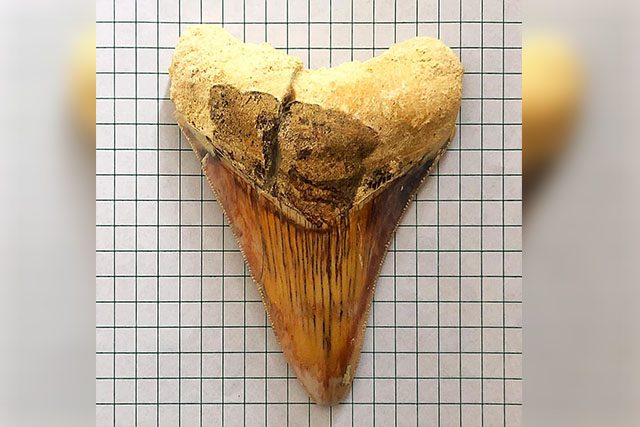
(Updated 10:14 p.m.) The National Museum Bohol last Tuesday presented online the second Megalodon or “giant shark” tooth fossil discovered in Bohol in time for the end of the observance of #CelebrateTheSea last month.
Local resident Christian Gio Bangalao found the tooth fossil, which measures 7.6 centimeters x 6.5 cm, in Barangay Jandig, of Maribojoc town and donated it to the National Museum last May 28.
In its “Shark Encounters in Bohol” series, the Bohol-based museum said it is the second Megalodon specimen found in the town of Maribojoc.
The first megalodon tooth was discovered by another local named Venjo Busalla on the grounds of the municipal plaza of Maribojoc on March 1, 2018.
“The 105mm. long and 65mm. wide tooth was seen half buried in the soil,” the NM’s statement read.
It has also been donated to the museum and is now on display in one of the galleries at the National Museum of Natural History in Manila together with other megalodon specimens from Cagayan and Pangasinan.
The museum management said that “Carcharocles megalodon, in some classification “Otodus megalodon,” meaning “giant tooth” is commonly known as megalodon.
It added that it “was the largest shark on record.”
Most fossils of the megalodon were determined to date back to the middle Miocene epoch to the Pliocene epoch, approximately 15.9 million to 2.6 million years ago.
“The species went extinct and disappeared from the fossil record about 2.6 million years ago. For comparison, the earliest specimens of early homo (humans) are dated to be from 2.5 to 2 million years ago,” it said.
Fossil remains suggest that the megashark species “share some similar anatomical features with the modern Great White Shark (Carcharodon carcharias).”
“These fossils give clues about the creature and why it went extinct. The average fossilized megalodon teeth specimens measure between 3 to 5 inches but bigger specimens measure up to 7 inches, three times larger than great white shark teeth,” the NM’s post read.
“Based on the fossil record, the largest megalodons would have reached about 60 ft. In comparison, the largest great white shark to date, measured only 21 ft,” it added.
Several other fossilized specimens of megalodon teeth have been unearthed in the Philippines.
Whale sharks were traditionally hunted in Bohol but the practice, described “unsustainable,” stopped after it was banned by virtue of Fisheries Administrative Order No. 193, Series of 1998.
“Fishing these gentle sharks is appalling to us today but then, it was the livelihood of fisherfolks who fished in the natural migratory paths of the whale sharks for generations,” the NM said.
Pamilacan island located off the coast of Baclayon had once been “center of whale shark fishing,” it added.
Whale shark hunters later turned to tourism following the ban.
Editor’s Note: Quotes on these stories have been revised in accordance with the changes made by the National Museum Bohol. Information on Carcharocles megalodon has also been updated.



